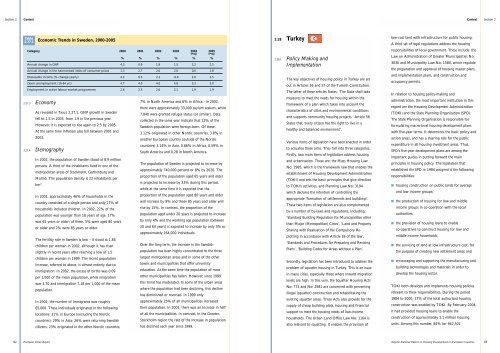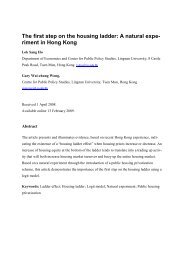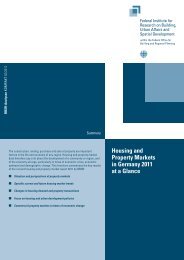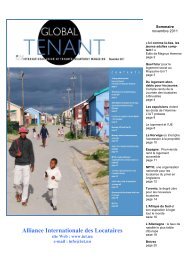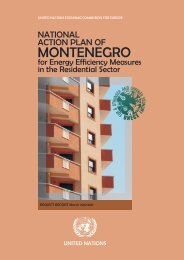housing developments in european countries - Department of ...
housing developments in european countries - Department of ...
housing developments in european countries - Department of ...
Create successful ePaper yourself
Turn your PDF publications into a flip-book with our unique Google optimized e-Paper software.
Section 2<br />
Context<br />
Context Section 2<br />
Table<br />
2.27.1<br />
Economic Trends <strong>in</strong> Sweden, 2000-2005<br />
Category 2000 2001 2002 2003 2004 2005<br />
(Proj) (Proj)<br />
% % % % % %<br />
Annual change <strong>in</strong> GNP 4.3 0.9 1.9 1.5 2.2 2.5<br />
Annual change <strong>in</strong> the harmonised <strong>in</strong>dex <strong>of</strong> consumer prices 1.3 2.7 2.0 2.0 0.6 1.8<br />
Disposable <strong>in</strong>come (% change yearly) 4.2 6.5 2.1 -0.8 2.0 2.5<br />
Open unemployment (16-64 yrs) 4.7 4.0 4.0 4.8 5.3 5.0<br />
Employment <strong>in</strong> active labour-market programmes 2.6 2.5 2.6 2.1 1.9 1.9<br />
2.27.3 Economy<br />
As revealed <strong>in</strong> TABLE 2.27.1, GNP growth <strong>in</strong> Sweden<br />
fell to 1.5 <strong>in</strong> 2003, from 1.9 <strong>in</strong> the previous year.<br />
However, it is expected to rise aga<strong>in</strong> to 2.5 by 2005.<br />
At the same time <strong>in</strong>flation also fell between 2001 and<br />
2003.<br />
2.27.4 Demography<br />
In 2002, the population <strong>of</strong> Sweden stood at 8.9 million<br />
persons. A third <strong>of</strong> the <strong>in</strong>habitants lived <strong>in</strong> one <strong>of</strong> the<br />
metropolitan areas <strong>of</strong> Stockholm, Gothenburg and<br />
Malmö. The population density is 22 <strong>in</strong>habitants per<br />
km 2 .<br />
In 2001, approximately 46% <strong>of</strong> households <strong>in</strong> the<br />
country consisted <strong>of</strong> a s<strong>in</strong>gle person and only 27% <strong>of</strong><br />
households <strong>in</strong>cluded children. In 2002, 22% <strong>of</strong> the<br />
population was younger than 18 years <strong>of</strong> age. 17%<br />
was 65 years or older; <strong>of</strong> these, 5% were aged 80 years<br />
or older and 2% were 85 years or older.<br />
The fertility rate <strong>in</strong> Sweden is low – it stood at 1.65<br />
children per woman <strong>in</strong> 2002, although it has risen<br />
slightly <strong>in</strong> recent years after reach<strong>in</strong>g a low <strong>of</strong> 1.5<br />
children per woman <strong>in</strong> 1999. The recent population<br />
<strong>in</strong>crease, referred to above, is almost entirely due to<br />
immigration. In 2002, the excess <strong>of</strong> births was 0.09<br />
per 1,000 <strong>of</strong> the mean population, while emigration<br />
was 3.70 and immigration 7.18 per 1,000 <strong>of</strong> the mean<br />
population.<br />
In 2002, the number <strong>of</strong> immigrants was roughly<br />
65,000. These <strong>in</strong>dividuals orig<strong>in</strong>ated <strong>in</strong> the follow<strong>in</strong>g<br />
locations: 31% <strong>in</strong> Europe (exclud<strong>in</strong>g the Nordic<br />
<strong>countries</strong>); 29% <strong>in</strong> Asia; 26% were return<strong>in</strong>g Swedish<br />
citizens; 23% orig<strong>in</strong>ated <strong>in</strong> the other Nordic <strong>countries</strong>;<br />
7% <strong>in</strong> North America and 6% <strong>in</strong> Africa. In 2002,<br />
there were approximately 33,000 asylum seekers, while<br />
7,840 were granted refugee status (or similar). Data<br />
collected <strong>in</strong> the same year <strong>in</strong>dicate that 12% <strong>of</strong> the<br />
Swedish population were foreign-born. Of these,<br />
3.12% orig<strong>in</strong>ated <strong>in</strong> other Nordic <strong>countries</strong>, 3.8% <strong>in</strong><br />
another European country (outside <strong>of</strong> the Nordic<br />
<strong>countries</strong>) 3.14% <strong>in</strong> Asia, 0.66% <strong>in</strong> Africa, 0.59% <strong>in</strong><br />
South America and 0.28 <strong>in</strong> North America.<br />
The population <strong>of</strong> Sweden is projected to <strong>in</strong>crease by<br />
approximately 740,000 persons or 8% by 2020. The<br />
proportion <strong>of</strong> the population aged 65 years and older<br />
is projected to <strong>in</strong>crease by 33% dur<strong>in</strong>g this period,<br />
while at the same time it is expected that the<br />
proportion <strong>of</strong> the population aged 80 years and older<br />
will <strong>in</strong>crease by 9% and those 85 years and older will<br />
rise by 15%. In contrast, the proportion <strong>of</strong> the<br />
population aged under 20 years is projected to <strong>in</strong>crease<br />
by only 4% and the work<strong>in</strong>g age population (between<br />
20 and 64 years) is expected to <strong>in</strong>crease by only 3% or<br />
approximately 164,000 <strong>in</strong>dividuals.<br />
Over the long term, the <strong>in</strong>crease <strong>in</strong> the Swedish<br />
population has been highly concentrated to the three<br />
largest metropolitan areas and <strong>in</strong> some <strong>of</strong> the other<br />
towns and municipalities that <strong>of</strong>fer university<br />
education. At the same time the population <strong>of</strong> most<br />
other municipalities has fallen. However, s<strong>in</strong>ce 1999<br />
this trend has moderated. In some <strong>of</strong> the urban areas<br />
where the population had been decl<strong>in</strong><strong>in</strong>g, this decl<strong>in</strong>e<br />
has dim<strong>in</strong>ished or reversed. In 1999 only<br />
approximately 25% <strong>of</strong> all municipalities <strong>in</strong>creased<br />
their population. In 2002, there was an <strong>in</strong>crease <strong>in</strong> half<br />
<strong>of</strong> all the municipalities. In contrast, <strong>in</strong> the Greater-<br />
Stockholm region the rate <strong>of</strong> the <strong>in</strong>crease <strong>in</strong> population<br />
has decl<strong>in</strong>ed each year s<strong>in</strong>ce 1999.<br />
2.28 Turkey<br />
2.28.1 Policy Mak<strong>in</strong>g and<br />
Implementation<br />
The key objectives <strong>of</strong> <strong>hous<strong>in</strong>g</strong> policy <strong>in</strong> Turkey are set<br />
out <strong>in</strong> Articles 56 and 57 <strong>of</strong> the Turkish Constitution.<br />
The latter <strong>of</strong> these articles States: ‘The State shall take<br />
measures to meet the needs for <strong>hous<strong>in</strong>g</strong> with<strong>in</strong> the<br />
framework <strong>of</strong> a plan which takes <strong>in</strong>to account the<br />
characteristics <strong>of</strong> cities and environmental conditions<br />
and supports community <strong>hous<strong>in</strong>g</strong> projects.’ Article 56<br />
States that ‘every citizen has the right to live <strong>in</strong> a<br />
healthy and balanced environment’.<br />
Various items <strong>of</strong> legislation have been enacted <strong>in</strong> order<br />
to actualise these aims. They fall <strong>in</strong>to three categories.<br />
Firstly, two ma<strong>in</strong> items <strong>of</strong> legislation address <strong>hous<strong>in</strong>g</strong><br />
and urbanisation. These are: the Mass Hous<strong>in</strong>g Law<br />
No: 2985, which is the framework law that enables the<br />
establishment <strong>of</strong> Hous<strong>in</strong>g Development Adm<strong>in</strong>istration<br />
(TOKI) and sets the basic pr<strong>in</strong>ciples that give direction<br />
to TOKI’s activities, and Plann<strong>in</strong>g Law No: 3194<br />
which declares the <strong>in</strong>tention <strong>of</strong> controll<strong>in</strong>g the<br />
appropriate ‘formation <strong>of</strong> settlements and build<strong>in</strong>gs’.<br />
These two items <strong>of</strong> legislation are also complemented<br />
by a number <strong>of</strong> by-laws and regulations, <strong>in</strong>clud<strong>in</strong>g:<br />
‘Standard Build<strong>in</strong>g Regulation for Municipalities other<br />
than Major (Metropolitan) Cities’, ‘Land and Property<br />
Shar<strong>in</strong>g with Realisation <strong>of</strong> the Compulsory Replott<strong>in</strong>g<br />
<strong>in</strong> accordance with Article 18 <strong>of</strong> the law’,<br />
‘Standards and Procedures for Prepar<strong>in</strong>g and Revis<strong>in</strong>g<br />
Plans’, ‘Build<strong>in</strong>g Codes for Areas without a Plan’.<br />
Secondly, legislation has been <strong>in</strong>troduced to address the<br />
problem <strong>of</strong> squatter <strong>hous<strong>in</strong>g</strong> <strong>in</strong> Turkey. This is an issue<br />
<strong>in</strong> many cities, especially those where <strong>in</strong>ward migration<br />
levels are high. In this ve<strong>in</strong>, the Squatter Hous<strong>in</strong>g Acts<br />
No: 775 and No: 2981 are concerned with prevent<strong>in</strong>g<br />
illegal (squatter) construction and rehabilitat<strong>in</strong>g the<br />
exist<strong>in</strong>g squatter areas. These Acts also provide for the<br />
supply <strong>of</strong> cheap build<strong>in</strong>g plots, <strong>hous<strong>in</strong>g</strong> and f<strong>in</strong>ancial<br />
support to meet the <strong>hous<strong>in</strong>g</strong> needs <strong>of</strong> low-<strong>in</strong>come<br />
households. The Urban Land Office Law No: 1164 is<br />
also relevant to squatt<strong>in</strong>g. It enables the provision <strong>of</strong><br />
low-cost land with <strong>in</strong>frastructure for public <strong>hous<strong>in</strong>g</strong>.<br />
A third set <strong>of</strong> legal regulations address the <strong>hous<strong>in</strong>g</strong><br />
responsibilities <strong>of</strong> local government. These <strong>in</strong>clude: the<br />
Law on Adm<strong>in</strong>istration <strong>of</strong> Greater Municipalities No:<br />
3030 and Municipality Law No: 1580, which regulate<br />
the preparation and approval <strong>of</strong> <strong>hous<strong>in</strong>g</strong> master plans<br />
and implementation plans, and construction and<br />
occupancy permits.<br />
In relation to <strong>hous<strong>in</strong>g</strong> policy-mak<strong>in</strong>g and<br />
adm<strong>in</strong>istration, the most important <strong>in</strong>stitution <strong>in</strong> this<br />
regard are the Hous<strong>in</strong>g Development Adm<strong>in</strong>istration<br />
(TOKI) and the State Plann<strong>in</strong>g Organisation (SPO).<br />
The State Plann<strong>in</strong>g Organisation is responsible for<br />
formulat<strong>in</strong>g macro-level <strong>hous<strong>in</strong>g</strong> development plans<br />
with five-year terms. It determ<strong>in</strong>es the basic policy and<br />
action areas, and has a steer<strong>in</strong>g role for the public<br />
expenditure <strong>in</strong> all <strong>hous<strong>in</strong>g</strong> <strong>in</strong>vestment areas. Thus,<br />
SPO’s five-year development plans are among the<br />
important guides <strong>in</strong> putt<strong>in</strong>g forward the ma<strong>in</strong><br />
pr<strong>in</strong>ciples <strong>in</strong> <strong>hous<strong>in</strong>g</strong> policy. The legislation that<br />
established the SPO <strong>in</strong> 1984 assigned it the follow<strong>in</strong>g<br />
responsibilities:<br />
■ <strong>hous<strong>in</strong>g</strong> construction on public lands for average<br />
and low <strong>in</strong>come groups;<br />
■ the production <strong>of</strong> <strong>hous<strong>in</strong>g</strong> for low and middle<br />
<strong>in</strong>come groups <strong>in</strong> co-operation with the local<br />
authorities;<br />
■ the provision <strong>of</strong> <strong>hous<strong>in</strong>g</strong> loans to enable<br />
co-operatives to construct <strong>hous<strong>in</strong>g</strong> for low and<br />
middle <strong>in</strong>come households;<br />
■ the servic<strong>in</strong>g <strong>of</strong> land at low <strong>in</strong>frastructure cost, for<br />
the purpose <strong>of</strong> creat<strong>in</strong>g new settlement areas and<br />
■ encourag<strong>in</strong>g and support<strong>in</strong>g the manufactur<strong>in</strong>g and<br />
build<strong>in</strong>g technologies and materials <strong>in</strong> order to<br />
develop the <strong>hous<strong>in</strong>g</strong> sector.<br />
TOKI both develops and implements <strong>hous<strong>in</strong>g</strong> policies<br />
relevant to these responsibilities. Dur<strong>in</strong>g the period<br />
1984 to 2000, 17% <strong>of</strong> the total authorised <strong>hous<strong>in</strong>g</strong><br />
construction was enabled by TOKI. By February 2004,<br />
it had provided <strong>hous<strong>in</strong>g</strong> loans to enable the<br />
construction <strong>of</strong> approximately 1.1 million <strong>hous<strong>in</strong>g</strong><br />
units. Among this number, 84% (or 942,501<br />
82 European Union Report<br />
Regular National Report on Hous<strong>in</strong>g Developments <strong>in</strong> European Countries<br />
83


